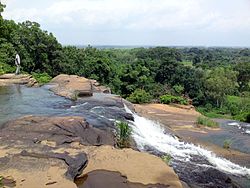Cascades Region
| Cascades | |
|---|---|
| Region | |
 |
|
 Location in Burkina Faso |
|
| Coordinates: 10°15′N 4°30′W / 10.250°N 4.500°WCoordinates: 10°15′N 4°30′W / 10.250°N 4.500°W | |
| Country |
|
| Capital | Banfora |
| Area | |
| • Total | 7,107 sq mi (18,406 km2) |
| Population (2006) | |
| • Total | 524,956 |
| Time zone | GMT 0 (UTC+0) |
Cascades is one of Burkina Faso's 13 administrative regions. It was created on 2 July 2001. The population of Cascades was 524,956 in 2006. It is the least populous region in Burkina Faso and contains 3.8% of all Burkinabé. The region's capital is Banfora. Two provinces, Comoé and Léraba, make up the region. The Cascades de Karfiguéla give the region its name.
As of 2010, the population of the region was 613,229 with 51.43 per cent females. As of 2007, the literacy rate in the region was 0 per cent, compared to a national average of 28.3 per cent. The coverage of cereal need compared to the total production of the region was 117.00 per cent.
Most of Burkino Faso is a wide plateau formed by riverine systems and is called falaise de Banfora. There are three major rivers, the Red Volta, Black Volta and White Volta, which cuts through different valleys. The climate is generally hot, with unreliable rains across different seasons. Gold and quartz are common minerals found across the country, while manganese deposits are also common. The dry season is usually from October to May and rains are common during the wet season from June to September. The soil texture is porous and hence the yield is also poor. The average elevation is around 200 m (660 ft) to 300 m (980 ft) above mean sea level. Among West African countries, Burkino Faso has the largest elephant population and the country is replete with game reserves. The southern regions are more tropical in nature and have Savannah and forests. The principal river is the Black Volta, that originates in the southern region and drains into Ghana. The areas near the rivers usually have flies like tsete and similium, which are carriers of sleep sickness and river blindness. The average rainfall in the region is around 100 cm (39 in) compared to northern regions that receive only 25 cm (9.8 in) rainfall.
...
Wikipedia
